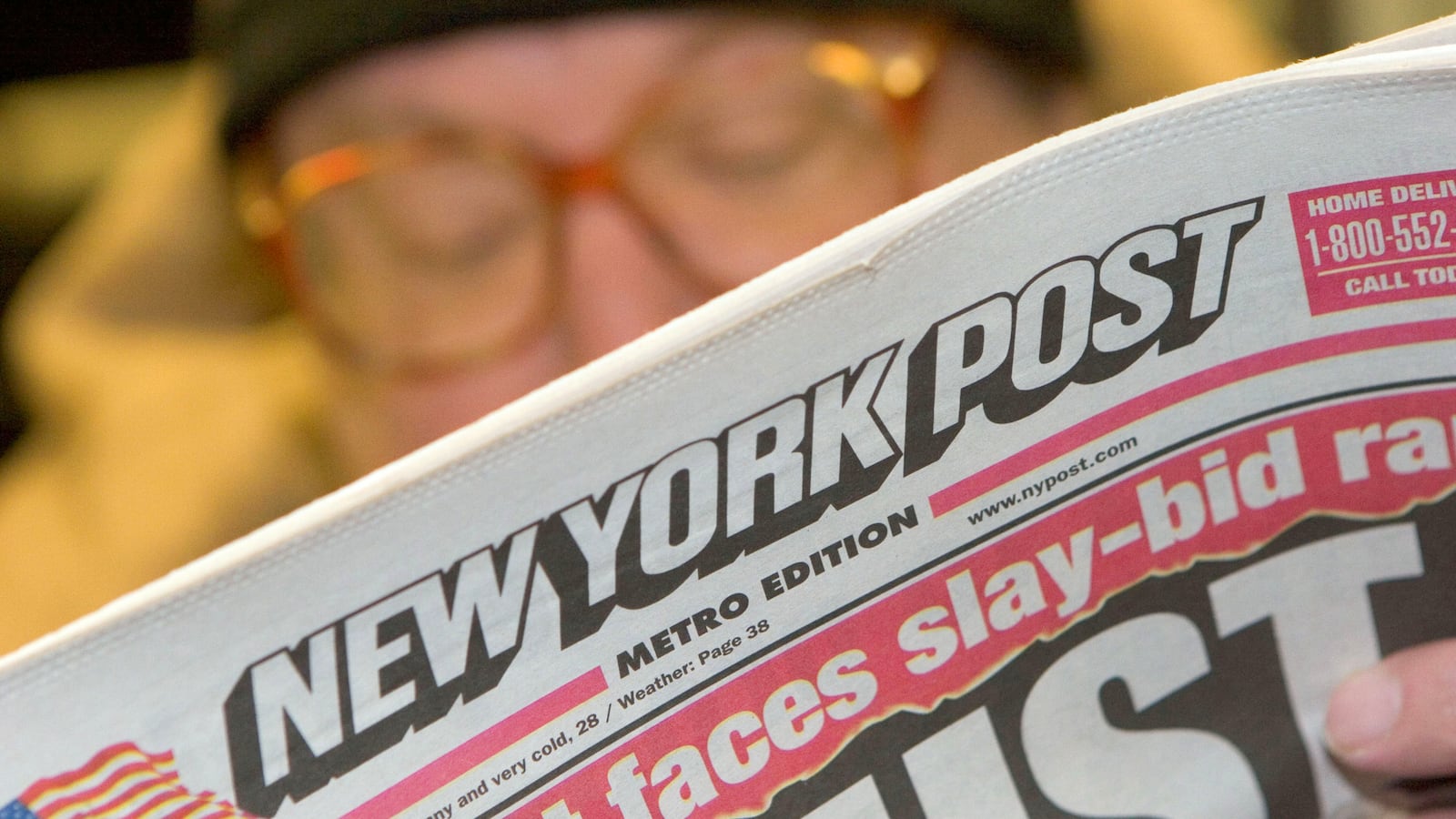In the days since News Corporation officially divided in half, its money-making movie and TV division on one side and its publishing arm on the other, the front page of the New York Post has been devoted to Derek Jeter’s ongoing injury trouble; a sitcom star leaving Scientology; an anonymously one-sourced story about Eliot Spitzer's wife disapproving of his run for office; and a rewrite of a report about Jennifer Lopez’s well-compensated performances before audiences of dictators and oligarchs. One cover since the June split has relied on a report in New York magazine. Another leaned heavily on an interview a local pol gave to a talk-radio host. Still another teased out the choicest bits from a new e-book Spitzer just published on how to police Wall Street.

The Post “wood,” as it is known in the journalistic argot, can drive the cultural and political conversation in New York like few other pieces of paper. And to be sure, the Post has had more than a few eye-catching stories this month, including one about James Gandolfini leaving the bulk of his fortune to his children after his death and another about the dismal conditions in the city’s 311 help-center workplaces. But it has been hard not to notice that the paper has lost a little of its bite of late.
These have been trying times in the newsroom on the Avenue of the Americas. Last month, the paper downsized, laying off about a dozen members of the editorial staff. Cuts have become a grim ritual in newsrooms around the country but are almost unheard of at the Post, which has relied on Rupert Murdoch’s largesse and his desire to shape the narrative of New York City. Now, with the layoffs and a number of editorial positions not being replaced, the newsroom “is like a ghost town,” said one Postie who, as did all the current and former Post staffers interviewed for this story, requested anonymity to avoid antagonizing the powers that be.
“You have all of these empty desks. They obviously haven’t replaced anybody,” said the newsroom insider. “There was uncertainty about what was going to happen [after the corporate split]. Then you have the buyouts, then you have the layoffs. It has been one wave after another.”
“It has been emotionally draining,” added another staffer. “We are trying to adjust to the new normal.”
And what of those Post scoops that used to set the city’s tongues on fire? It’s been a while since the paper broke a story like the one it had in April, when a front page featured two local pols who were about to be arrested for corruption—before the pols themselves even knew it. Or since the Post report from 2008 that Mayor Mike Bloomberg was preparing to toss the city’s term-limits law and run again, a full five months before the mayor announced it himself. The paper seems noticeably thinner these days, with more stories coming in from wire services.
The Post has always been more of a shoestring operation than casual readers realize, with the same writers often scoring upward of a half-dozen bylines in one paper and a disproportionate share of the burden falling on young freelancers. It’s a place where, as one writer described, writers were forced to put some PR swag found in a closet up for auction on eBay to pay for beer for a Christmas party. And now, with the goodbye parties at one of the Irish bars across the street from News Corp. headquarters kicking off with greater frequency—up to several times a week, according to one staffer—can the Post continue to be New York’s Fleet Street daily?
Working at the Post, current and former staffers say, is an experience unlike any other in journalism. Pariahs in elite media circles, reporters there tend to revel in being the bad boys and girls at the garden party. It is a place where cease-and-desist letters are hung on the wall with pride. And there is a security to working at the paper that other prestige outlets lack. Or there was, at least.
“People were happy there because so many newspapers were having such trouble,” said one former staffer. “Papers where you never thought you would see layoffs, like the L.A. Times, The New York Times, The Washington Post, were suddenly laying off staffers. So you could criticize the Post all you want, but you knew you were not going to be laid off tomorrow.”
Continued the staffer: “You were trading status for stability. That is why this recent round of layoffs is a real problem. It is now just like any other paper.”
The layoffs and buyouts seemed targeted at those with the biggest salaries who also naturally had been there the longest. The political editor left and was replaced by the City Hall bureau chief, a fixture downtown who seemed to know more about the doings of government than those in it. There is currently no education reporter, no Albany bureau chief. Longtime court and outer borough reporters have been brought back into the newsroom, staffers say, creating an odd catch-22 for editors. They will dispatch staffers only to the places where news is happening, but it is harder to make news happen—especially the kind that takes years of source-building—without reporters around.
“We are just incredibly short-staffed right now,” said one staffer. “Everyone is incredibly stressed out.”
Posties worry that News Corp. is about to embark on an experiment with the paper—whether a big-city tabloid can be produced largely by freelancers.
Last month, Robert Thomson, CEO of the new News Corp., said the paper needed to reframe itself to compete with BuzzFeed, the upstart news site that has transitioned from a place that featured mostly cat GIFs to a robust news outlet that breaks news online throughout the day. Many interviewed for this article cheered the announcement, saying it was long past time that the paper caught up to the 21st century, but others wondered how the Post could possibly pull it off. The website remains clunky to navigate, and the digital team is small compared with other outlets.
“That is all well and good,” said one ex-Postie. “But the website is run by three men and a donkey.”
In a statement in response to a request for an interview with the paper’s top brass, a New York Post spokesperson said: “Every day, the most powerful and influential people living in the most powerful and influential city in the world read the New York Post and love it. Our brand and our business is getting bigger and stronger through digital and we’re excited by what’s ahead.”
Those interested in Post palace intrigue, though, wondered if something else was afoot with the announcement. Late last year, Jesse Angelo was named publisher of the paper. Angelo had previously been editor of the now-defunct online News Corp. newspaper The Daily, and some saw his soft landing as a sign he was being prepped to take over for Col Allan, the Post’s legendary editor. A former Postie said staffers there pore over an in-house Tumblr called Murdoch Here that charts the press baron’s travels around the globe and note how often Angelo appears alongside Murdoch versus Allan. That there are new editors at Murdoch-owned properties around the globe from Melbourne to London has increased the sense that the Post is due for some changes.
“Col is a great newspaperman, has a great tabloid sensibility, but what does he know about turning the paper into BuzzFeed?” said one former staffer. “The joke going around was that he was going to try to put a GIF on the front page.”
More worrisome, though, staffers say, is a persistent concern that not long ago was unthinkable in New York: one day soon the New York Post may cease to print at all. The Post is reportedly thought to lose more than $100 million a year. After the corporate split, the paper will no longer have blockbuster movies to backstop it. The benefits of the previous relationship were not lost on anyone. One Post writer described receiving emails when movies produced by 20th Century Fox scored big at the box office.
“When Avatar made all that money, you would get a weird email from Rupert about it,” said the writer. “It is not like anybody can wonder who is paying the bills.”
And so could New York become a two-newspaper town, a situation the city was last in under British rule?
“Everybody is asking that, and no one knows,” said one former staffer. “That has always been a hallmark of the place. You never find out anything until it has already happened.”
Editors’ Note: The original version of this piece attributed the New York Post statement to a News Corp. spokesperson. It has been updated to reflect that it was a Post spokesperson.






